Japanese knives are popular worldwide for their superior sharpness. However, they have unique characteristics depending on the production region. Furthermore, professionals must take factors beyond sharpness, such as durability and ease of maintenance, into consideration. A former chef of Japanese cuisine took all these elements into consideration to select the best Japanese kitchen knives, rating them with stars. This article will introduce not only Japanese knives that are perfect for Japanese cuisine, but also easy-to-use steel "gyuto" (chef's knife), as well as what to look for when buying Japanese knives online, and how to maintain your Japanese knives.
What to Look For When Buying Japanese Knives Online
Upon doing some research, we have found that it is quite difficult to find Japanese kitchen knives made by highly skilled craftspeople in online shops outside of Japan. In addition, some major Japanese knife manufacturers have production sites overseas, so the knives made at those facilities may be touted as "Japanese knives" but are not actually made in Japan.
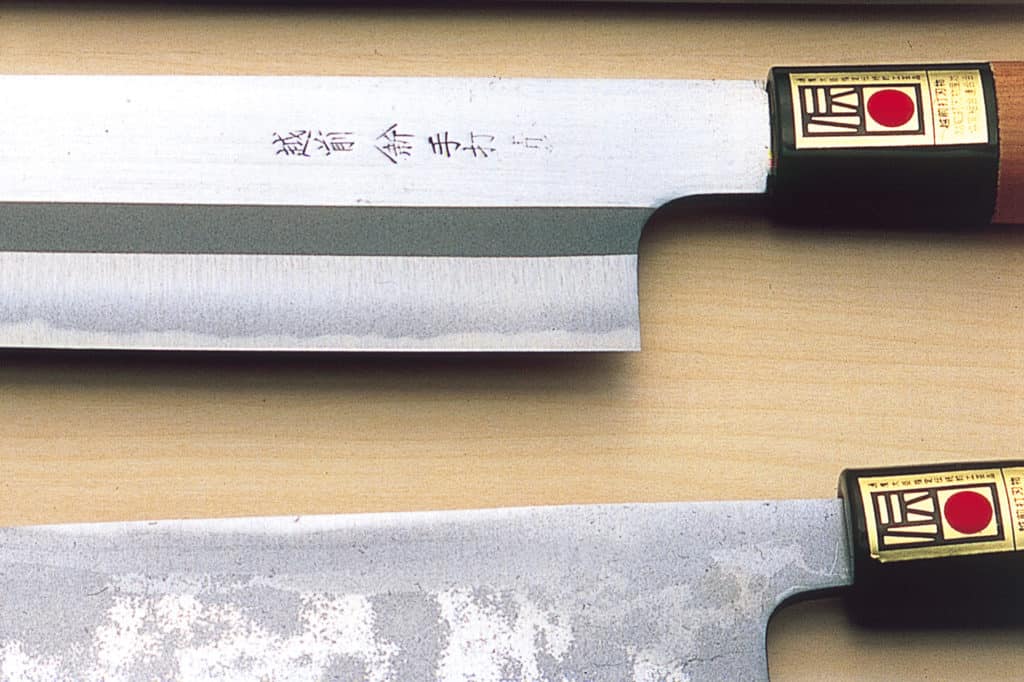
Sakai cutlery, which has a history that dates back over 600 years and is said to be used by 90% of Japanese chefs, and Echizen cutlery (pictured above), which go back nearly 700 years, have both been designated as traditional Japanese crafts by the Japanese government, with strict regulations on their manufacturing processes. It is illegal to sell counterfeits in Japan, and genuine products have the golden sticker shown in the picture above that identifies them as true traditional Japanese crafts.
So, if you want a real Japanese kitchen knife made by a craftsman, be sure to get one that is:
・Sold in Japan with the the production site clearly marked
・Has a sticker that identifies it as a traditional Japanese craft or is an official sticker of a manufacturer's association
If you look for the above, you are sure to get a proper Japanese knife. Of course, there are many excellent kitchen knives that are not designated as traditional Japanese crafts, but the designation is only one reliable criterion. Also, traditional Japanese crafts can come in varying grades of quality, and some may suit you better than others, so be sure to do your due diligence before purchasing one.
High-quality Japanese kitchen knives are said to "last for life" and can withstand everyday usage by chefs, but only if they are cared for properly.
How to Care for Japanese Kitchen Knives
Sharpen
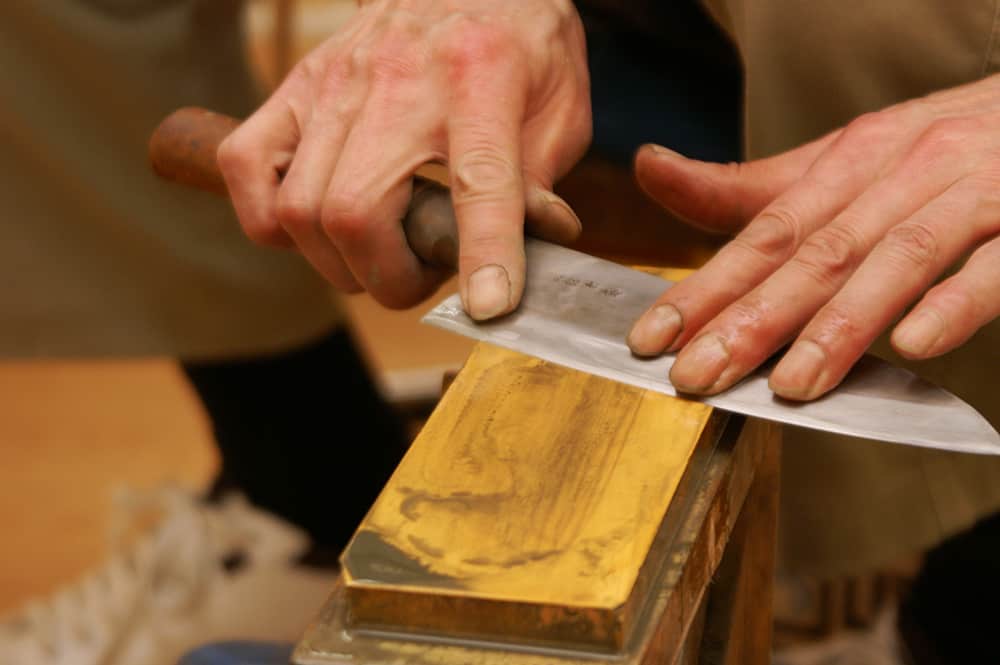
Sharpening is an absolute must for the knives to remain sharp. There are many excellent sharpeners out in the market today that can keep the knives sharp, but a whetstone must be used if there are any chips. I personally use a coarse ceramic sharpener, medium-fine sharpener, a natural finishing stone from Kyoto, and a diamond whetstone sharpening chisel. Take a look at the video below by Jikko, a Japanese knife manufacturer that has been making knives in Sakai City for 110 years, for some guidance.
Premium Knife Sharpening Stone Set – 400/1000 and 3000/8000-Grit Professional
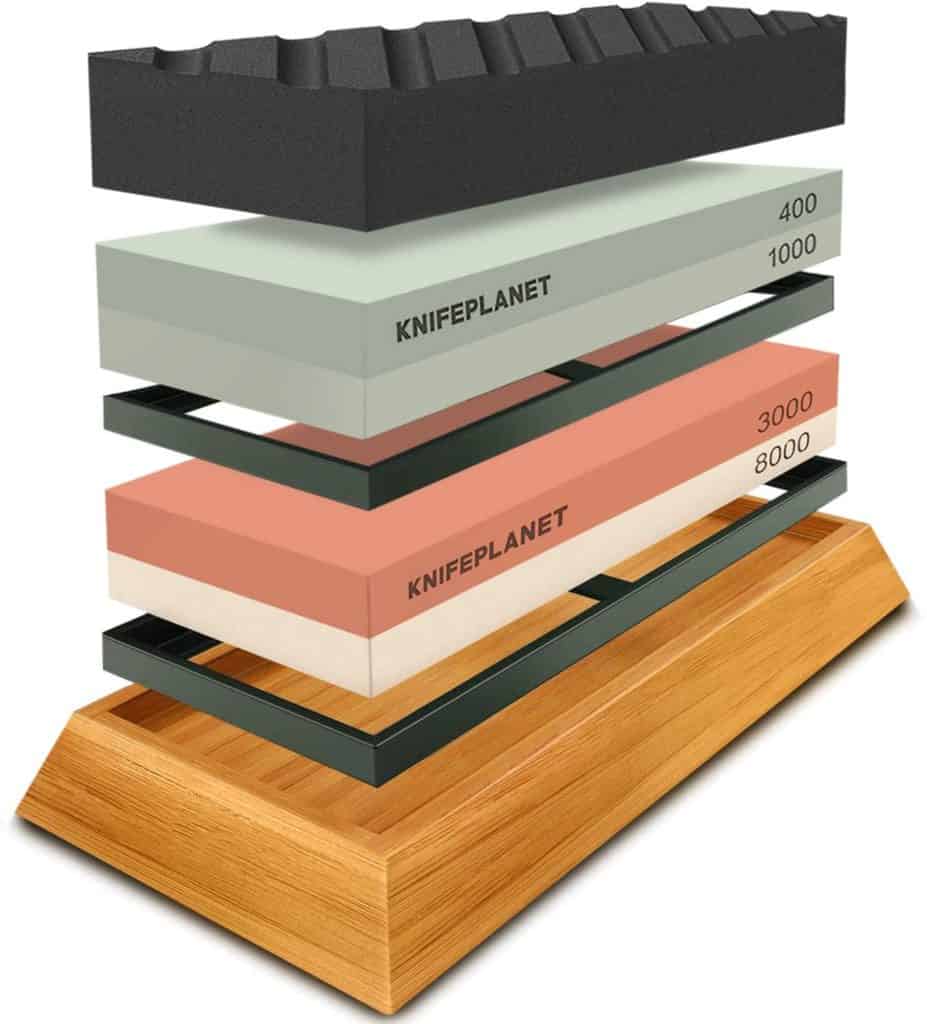
Choose a Rust-Resistant Knife
High-end Japanese knives tend to be made with high-quality steel* which is prone to rust if not properly cared for. Even stainless steel knives do rust, even though it may not be obvious to the eye. The rust will gradually corrode the inside of the knife if left alone, so it is critical that it be dealt with as early as possible. When rust is scrubbed off repeatedly using a hard sponge (the smooth surface of a wine cork works) and cleanser, an oxide film is created, making the steel less susceptible to rust. So, if you repeat this process daily after purchasing the knife, it becomes less likely to rust. Knives can also be protected against rust by rubbing oil on the blades (refer to the video below).
*Generally speaking, Japanese knives made of steel with high carbon content are more expensive and actually more delicate and prone to chipping.
A Note of Caution
Never put a knife over a flame to evaporate the moisture. High-quality Japanese knives are hardened with heat during production, but the benefits of the hardening process can be affected by putting a knife over a flame, and its function and sharpness can be ruined considerably. To get the moisture out, pour hot water over the knife as shown in the video above.
Related article: ▶ 46 Japan-Made Tableware Used in Japanese Restaurants
Featured Products
1. Sakai Genkichi Japanese Carbon Steel Chef Knife, 300mm, Made in Japan

Score: ★★★☆☆
This is a chef's knife made by Daikichi Co. Ltd., a member of the Federation of Sakai Cutlery Commerce and Industry Associations in Sakai City, the home of Sakai cutlery. There are strict regulations for the production of Sakai cutlery ("Sakai Uchihamono"), including "the production process of hammering and hardening; the material, which must be carbon steel or a combination* of iron and carbon steel; and the handle, which must be wood," and they are mainly classic Japanese-style kitchen knives.
This Japanese knife is made with traditional Sakai cutlery production techniques that have been handed down over the generations, but the steel is "nihon-ko" (standard Japanese steel that has long been used for kitchen knives) which is easier to use and the size is suited to chefs. It is a very sharp knife, but it also rusts easily, so it needs to be cared for as described earlier. Taking its quality and price into consideration, it is recommended for those purchasing their first Japanese knife. There is a slightly smaller size for those who may find this one to be too large.
*Reference: The Association for the Promotion of Traditional Craft Industries
(一般財団法人 伝統的工芸品産業振興会 「伝統的工芸品ハンドブック 改訂版」)
Blade Length: 300 mm / 11.8" / 30 cm
Blade Material: Nihon-ko (Japanese steel)
Brand: Sakai Genkichi
1-2. Sakai Genkichi Japanese Carbon Steel Chef Knife, 270mm, Made in Japan

2. SAKAI KIKUMORI SKK Vanadium Steel Without Bolster, Household Gyuto/Chef's Knife (240mm/9.4"/24cm)
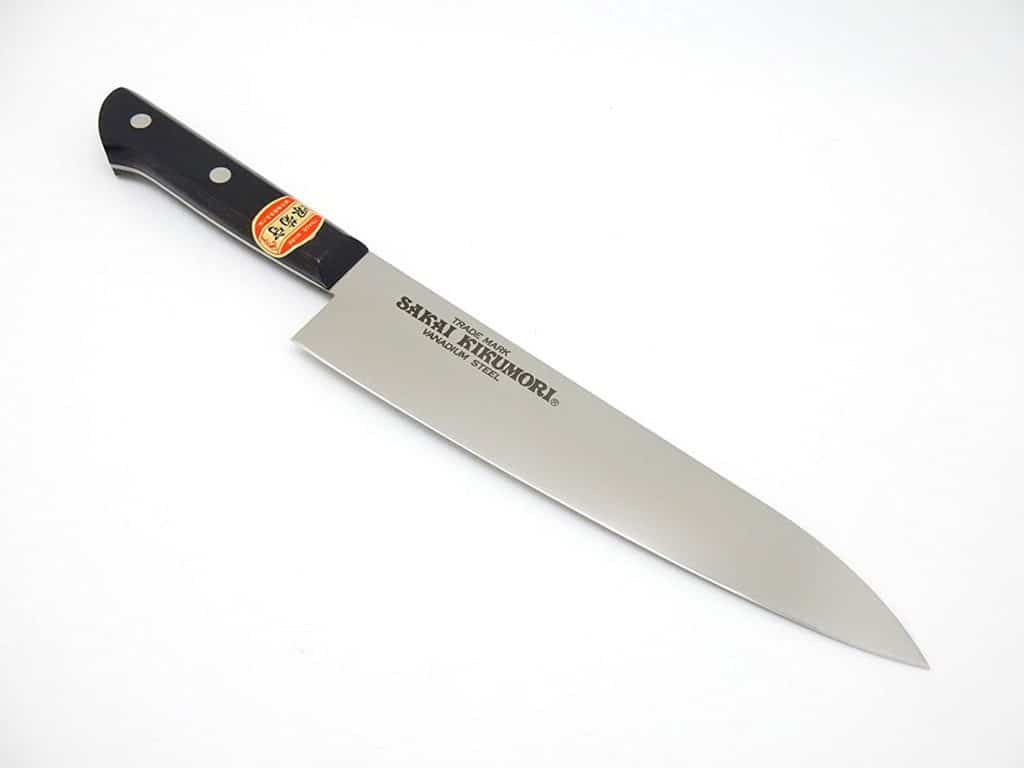
Score: ★★★★☆
This is also a chef's knife by another member of the Federation of Sakai Cutlery Commerce and Industry Associations, Kawamura Hamono Co. Ltd. It is made using SKK Vanadium Steel, which is rust-resistant and retains sharpness. It is a Japanese knife made with traditional Sakai cutlery techniques and is suited for professionals. The 9.3-inch and 8.3-inch Japanese knives are available on Amazon.com, but if you would like a larger knife, head over to Amazon.co.jp.
Blade Length : 240 mm / 9.4" / 24 cm
Blade Material: SKK Vanadium Steel
Brand: SAKAI KIKUMORI
2-1. SAKAI KIKUMORI SKK Vanadium Steel Without Bolster, Household Gyuto/Chef's Knife (270mm/ 10.6") with Bolster

This is another chef's knife by Kawamura Hamono, but it has a bolster between the knife blade and handle. The bolster is a matter of preference.
3. SAKAI TOJI DAMASCUS STEEL CHEF'S KNIFE (240mm / 9.4" /24cm)
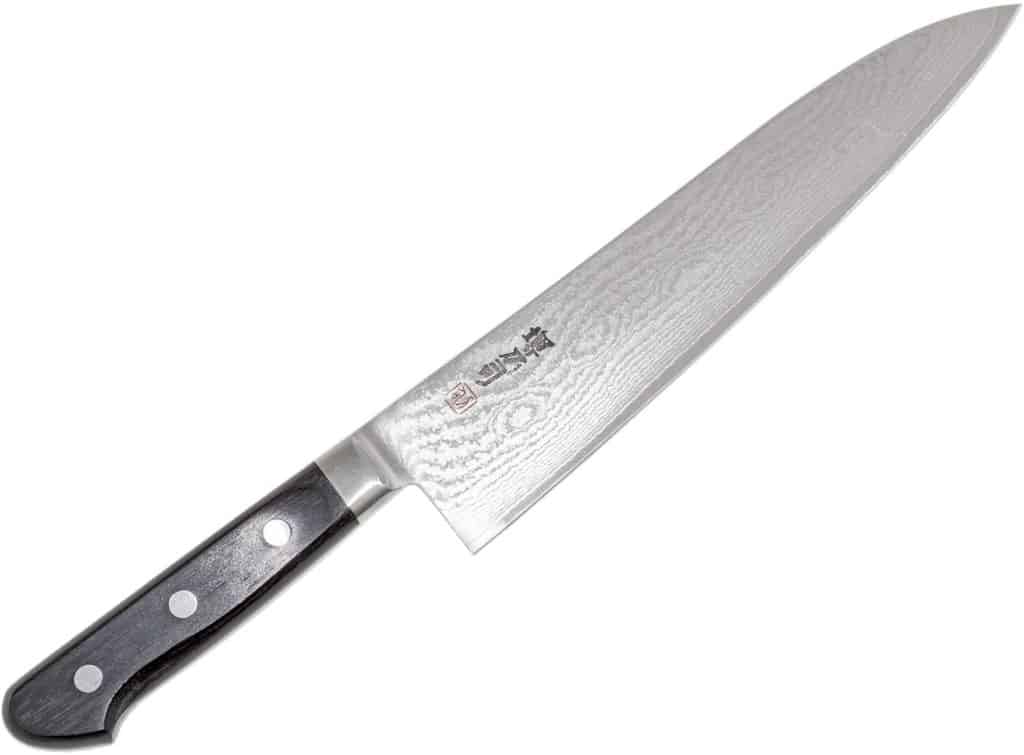
Score: ★★★★★
This is a chef's knife by a member of the Federation of Sakai Cutlery Commerce and Industry Associations, Izumiriki Seisakusho. It is distinguished by its 35 layers of Damascus steel. Not only are the rippled patterns beautiful, but compared to single-layered steel, multi-layered steel is stronger and makes the blade more stable. Multi-layered knives are also sharper and do not rust easily. They are difficult to produce, but dividing the tasks among skilled craftsmen, which is a feature of Sakai cutlery, makes it possible to create this high-quality kitchen knife.
Blade Length : 240 mm / 9.4" / 24 cm
Blade Material: Damascus steel, black veneer
Brand: SAKAI TOJI
4. Ittosai-Kotetsu INOX Swedish Steel Gyuto (double-edged blade) Olive Wood Handle 240mm
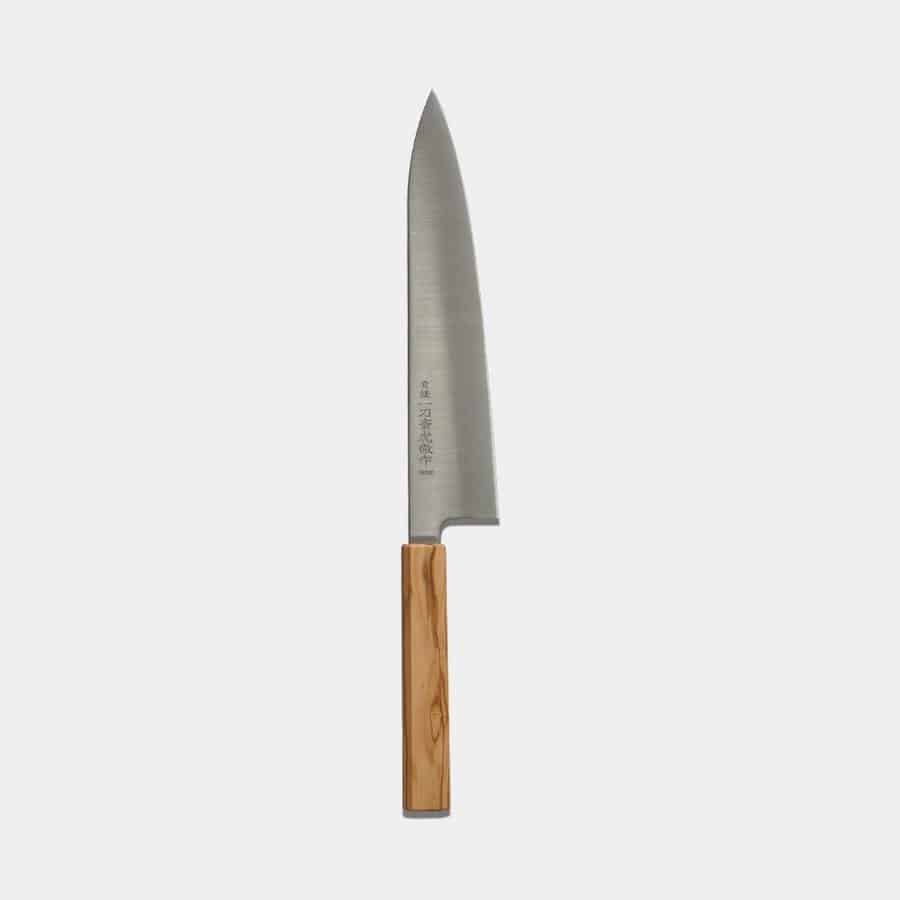
Score: ★★★★★
This is a chef's knife by a member of the Federation of Sakai Cutlery Commerce and Industry Associations, Takahashi Kusu. It is produced using the reliable techniques of Sakai cutlery, but what distinguishes it is the use of Swedish steel. It is categorized as a stainless steel knife. Because there are very few impurities in the steel, the knife is sharp, rust-resistant, and does not wear easily. It boasts superior ease of use among Japanese knives and is created by some of the most experienced craftsmen in Sakai. It is a Japanese knife that chefs aspire to own and use.
Size: Blade length: 9.05" (23 cm)
Weight: 0.57 lbs (260 g)
Material: Steel: Swedish steel, Handle: Olive wood
Brand: TAKAHASHI KUSU
5. Go Uma Mitsuyoshi Yoshihiro Shiraji Steel Water-Grilled Honyaki Yanagiha Knife 300Mm Mirror Surface Wave Floating-Senbon Black Persimmon Handle Sheath Specification With Gutter

Score: ★★★★★
This next Japanese knife is a particularly high-quality "yanagiba" (willow-leaf blade). The blade is made of "shirohagane" (white steel; also known as "shirogami"), which has a higher carbon content than nihon-ko. The higher the carbon content, the harder the steel is, but at the same time, it becomes more delicate and prone to chipping. Shirohagane are categorized by numbers from 1 to 3, with the carbon content increasing the lower the number. This Japanese knife is made with no. 2 shirohagane, which is the easiest to use.
It is a "honyaki," meaning it is made just with steel, which means it is hard but extremely difficult to handle and can even split in two. Furthermore, to make it, they use a process called "mizuyaki"(water-quenching) wherein the steel is quickly cooled using water during the hardening process. While this results in a more delicate sharpness, it is so difficult to perform that even a veteran Sakai cutlery craftsperson will have several broken blades for every ten that he makes. Therefore, this Japanese knife is very expensive. It is the ultimate luxury knife that chefs of Japanese cuisine aspire to own.
Size: 17.71" (45 cm)
Weight: 0.47 lbs (215 g)
Material: Blade: Shironi Steel Water-grilled Honyaki / Handle: Thousand black persimmon pattern / Sheath: Thousand black persimmon sheath
Brand: Yamawaki Cutlery (Sakai Forged Blades)
In Conclusion
Japanese kitchen knives, which have their roots in Japanese swords, have a long history and are knives that have been made with a pursuit of sharpness. This also makes them difficult to use. However, sharp knives are indispensable for Japanese cooking, which requires dishes to be made without spoiling the natural flavors of the ingredients. It has been proven scientifically that when sashimi is cut with a dull knife, the fish's cells are damaged and the flavors affected dramatically. This is not only in Japanese cooking; it would be anathema to any chef to serve dishes with sub-par flavors just because the ingredients were cut with dull knives.
A professional chef deserves to use the highest quality tools, and Japan's outstanding kitchen knives are sure to be a great tool for you in the kitchen.
Related articles:
▶ 8 Things You Didn’t Know About Japanese Kitchen Knives
▶ Introducing Echizen Uchihamono, Classic Japanese Kitchen Knives
▶ The Complete Guide to Traditional Japanese Crafts
If you want to give feedback on any of our articles, you have an idea that you'd really like to see come to life, or you just have a question on Japan, hit us up on our Facebook, Twitter, or Instagram!
*These products may not be able to be shipped to certain countries. Please see the retailer's website for more information.
The information in this article is accurate at the time of publication.
